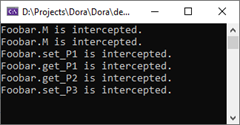全新升级的AOP框架Dora.Interception[4]: 基于表达式的拦截器注册
基于特性标注的拦截器注册方式仅限于将拦截器应用到自己定义的类型上,对于第三方提供的类型就无能为力了。对于Dora.Interception(github地址,觉得不错不妨给一颗星)来说,拦截器注册本质上建立拦截器与一个或者多个目标方法之间的映射,所以最笨的方式就是利用反射的方式得到表示目标方法的MethodInfo对象,并将它与对应的拦截器关联在一起。这种方式虽然能够解决问题,但是编程体验很差。本篇介绍的基于表达式的拦截器注册方式利用针对目标方法或者属性的调用表达式,以一种强类型的方式获取到目标方法,极大地改善了编程体验。(拙著《ASP.NET Core 6框架揭秘》6折优惠,首印送签名专属书签)
一、IInterceptorRegistry
以表达式采用强类型的方式将指定类型的拦截器应用到目标方法上是借助如下这个IInterceptorRegistry接口完成的。IInterceptorRegistry接口提供了一个For<TInterceptor>方法以待注册的拦截器类型关联,参数arguments用来提供构建拦截器对象的参数。该方法会返回一个IInterceptorRegistry<TInterceptor>对象,它提供了一系列的方法帮助我们将指定的拦截器应用到指定目标类型(通过泛型参数类型TTarget表示)相应的方法上。
public interface IInterceptorRegistry { IInterceptorRegistry<TInterceptor> For<TInterceptor>(params object[] arguments); ... } public interface IInterceptorRegistry<TInterceptor> { IInterceptorRegistry<TInterceptor> ToAllMethods<TTarget>(int order); IInterceptorRegistry<TInterceptor> ToMethod<TTarget>(int order, Expression<Action<TTarget>> methodCall); IInterceptorRegistry<TInterceptor> ToMethod(int order, Type targetType, MethodInfo method); IInterceptorRegistry<TInterceptor> ToGetMethod<TTarget>(int order, Expression<Func<TTarget, object?>> propertyAccessor); IInterceptorRegistry<TInterceptor> ToSetMethod<TTarget>(int order, Expression<Func<TTarget, object?>> propertyAccessor); IInterceptorRegistry<TInterceptor> ToProperty<TTarget>(int order, Expression<Func<TTarget, object?>> propertyAccessor); }
封装了IServiceCollection集合的InterceptionBuilder提供了一个RegisterInterceptors扩展方法,我们可以利用该方法定义的Action<IInterceptorRegistry>类型的参数来使用上述的这个IInterceptorRegistry接口。不论是IServiceCollection接口的BuildInterceptableServiceProvider扩展方法,还是IHostBuilder接口的UseInterception方法均提供了一个可选的Action<InterceptionBuilder>委托类型的参数。
public sealed class InterceptionBuilder { public IServiceCollection Services { get; }
public InterceptionBuilder(IServiceCollection services); } public static class Extensions { public static InterceptionBuilder RegisterInterceptors(this InterceptionBuilder builder, Action<IInterceptorRegistry> register); public static IServiceProvider BuildInterceptableServiceProvider(this IServiceCollection services, Action<InterceptionBuilder>? setup = null); public static IHostBuilder UseInterception(this IHostBuilder hostBuilder, Action<InterceptionBuilder>? setup = null); }
二、将拦截器应用到某个类型
类似与将InterceptorAttribute标注到某个类型上,我们也可以采用这种方式将指定的拦截器应用到目标类型上,背后的含义就是应用到该类型可以被拦截的所以方法上(含属性方法)。
public class FoobarInterceptor { public ValueTask InvokeAsync(InvocationContext invocationContext) { var method = invocationContext.MethodInfo; Console.WriteLine($"{method.DeclaringType!.Name}.{method.Name} is intercepted."); return invocationContext.ProceedAsync(); } } public class Foobar { public virtual void M() { } public virtual object? P { get; set; } }
我们可以采用如下的方式将调用IInterceptorRegistry<TInterceptor>的ToAllMethods<TTarget>方法将上面定义的拦截器FoobarInterceptor应用到Foobar类型的所有方法上。
var foobar = new ServiceCollection() .AddSingleton<Foobar>() .BuildInterceptableServiceProvider(interception => interception.RegisterInterceptors(RegisterInterceptors)) .GetRequiredService<Foobar>(); foobar.M(); foobar.P = null; _ = foobar.P; static void RegisterInterceptors(IInterceptorRegistry registry) { var foobar = registry.For<FoobarInterceptor>(); foobar.ToAllMethods<Foobar>(order: 1); }
从如下所示的执行结果可以看出,Foobar类型的M方法和P属性均被FoobarInterceptor拦截下来(源代码)。
三、应用到指定的方法和属性
我们可以通过指定调用方法或者获取属性的表达式来指定拦截器应用的目标方法。我们将目标类型Foobar定义成如下的形式,两个重载的M方法和三个属性均是可以拦截的。
public class Foobar { public virtual void M(int x, int y) { } public virtual void M(double x, double y) { } public virtual object? P1 { get; set; } public virtual object? P2 { get; set; } public virtual object? P3 { get; set; } }
我们利用如下的代码将上面定义的FoobarInterceptor应用到Foobar类型相应的成员上。具体来说,我们调用ToMethod<TTarget>方法应用到两个重载的M方法,调用ToProperty<TTarget>方法应用到P1属性的Get和Set方法上,调用ToGetMethod<TTarget>和ToSetMethod<TTarget>方法应用到P2属性的Get方法和P3属性的Set方法。
var provider = new ServiceCollection() .AddSingleton<Foobar>() .BuildInterceptableServiceProvider(interception => interception.RegisterInterceptors(RegisterInterceptors)); var foobar = provider.GetRequiredService<Foobar>(); foobar.M(1, 1); foobar.M(3.14, 3.14); foobar.P1 = null; _ = foobar.P1; foobar.P2 = null; _ = foobar.P2; foobar.P3 = null; _ = foobar.P3; Console.ReadLine(); static void RegisterInterceptors(IInterceptorRegistry registry) { var foobar = registry.For<FoobarInterceptor>(); foobar .ToMethod<Foobar>(order: 1, it => it.M(default(int), default(int))) .ToMethod<Foobar>(order: 1, it => it.M(default(double), default(double))) .ToProperty<Foobar>(order: 1, it => it.P1) .ToGetMethod<Foobar>(order: 1, it => it.P2) .ToSetMethod<Foobar>(order: 1, it => it.P3) ; }
程序运行后,针对Foobar相应成员的拦截体现在如下所示的输出结果上(源代码)。
四、指定构建拦截器的参数
如果应用的拦截器类型构造函数指定了参数,我们采用这种注册方式的时候也可以指定参数。以如下这个FoobarInterceptor为例,其构造函数中指定了两个参数,一个是代表拦截器名称的name参数,另一个是IFoobar对象。
public class FoobarInterceptor { public FoobarInterceptor(string name, IFoobar foobar) { Name = name; Foobar = foobar; } public string Name { get; } public IFoobar Foobar { get; } public ValueTask InvokeAsync(InvocationContext invocationContext) { Console.WriteLine($"{invocationContext.MethodInfo.Name} is intercepted by FoobarInterceptor {Name}."); Console.WriteLine($"Foobar is '{Foobar.GetType()}'."); return invocationContext.ProceedAsync(); } } public interface IFoobar { } public class Foo : IFoobar { } public class Bar: IFoobar { } public class Invoker { public virtual void M1() { } public virtual void M2() { } }
由于字符串参数name无法从依赖注入容器提取,所以在注册FoobarInterceptor是必须显式指定。如果容器能够提供IFoobar对象,但是希望指定一个不通过的对象,也可以在注册的时候显式指定一个IFoobar对象。我们按照如下的方式将两个不同的FoobarInterceptor对象分别应用到Invoker类型的Invoke1和Invoke2方法上,并分别将名称设置为Interceptor1和Interceptor2,第二个拦截器还指定了一个Bar对象作为参数(容器默认提供的IFoobar对象的类型为Foo)。
var invoker = new ServiceCollection() .AddSingleton<Invoker>() .AddSingleton<IFoobar, Foo>() .BuildInterceptableServiceProvider(interception => interception.RegisterInterceptors(RegisterInterceptors)) .GetRequiredService<Invoker>(); invoker.M1(); Console.WriteLine(); invoker.M2(); static void RegisterInterceptors(IInterceptorRegistry registry) { registry.For<FoobarInterceptor>("Interceptor1").ToMethod<Invoker>(order: 1, it => it.M1()); registry.For<FoobarInterceptor>("Interceptor2", new Bar()).ToMethod<Invoker>(order: 1, it => it.M2()); }
程序运行之后,两个FoobarInterceptor对象的名称和依赖的IFoobar对象的类型以如下的形式输出到控制台上(源代码)。
五、拦截屏蔽
除了用来注册指定拦截器的For<TInterceptor>方法,IInterceptorRegistry接口还定义了如下这些用来屏蔽拦截的SuppressXxx方法。
public interface IInterceptorRegistry { IInterceptorRegistry<TInterceptor> For<TInterceptor>(params object[] arguments); IInterceptorRegistry SupressType<TTarget>(); IInterceptorRegistry SupressTypes(params Type[] types); IInterceptorRegistry SupressMethod<TTarget>(Expression<Action<TTarget>> methodCall); IInterceptorRegistry SupressMethods(params MethodInfo[] methods); IInterceptorRegistry SupressProperty<TTarget>(Expression<Func<TTarget, object?>> propertyAccessor); IInterceptorRegistry SupressSetMethod<TTarget>(Expression<Func<TTarget, object?>> propertyAccessor); IInterceptorRegistry SupressGetMethod<TTarget>(Expression<Func<TTarget, object?>> propertyAccessor); }
我们可以采用如下的方式会将屏蔽掉Foobar类型所有成员的拦截特性,虽然拦截器FoobarInterceptor被注册到了这个类型上(源代码)。
var foobar = new ServiceCollection() .AddSingleton<Foobar>() .BuildInterceptableServiceProvider(interception => interception.RegisterInterceptors(RegisterInterceptors)) .GetRequiredService<Foobar>(); ... static void RegisterInterceptors(IInterceptorRegistry registry) { registry.For<FoobarInterceptor>().ToAllMethods<Foobar>(order: 1); registry.SupressType<Foobar>(); }
下面的程序明确屏蔽掉Foobar类型如下这些方法的拦截能力:M方法,P1属性的Get和Set方法(如果有)以及P属性的Get方法(源代码)。
var foobar = new ServiceCollection() .AddSingleton<Foobar>() .BuildInterceptableServiceProvider(interception => interception.RegisterInterceptors(RegisterInterceptors)) .GetRequiredService<Foobar>(); ... static void RegisterInterceptors(IInterceptorRegistry registry) { registry.For<FoobarInterceptor>().ToAllMethods<Foobar>(order: 1); registry.SupressMethod<Foobar>(it=>it.M()); registry.SupressProperty<Foobar>(it => it.P1); registry.SupressGetMethod<Foobar>(it => it.P2); }
六、两个后备方法
通过指定调用目标方法或者提取属性的表达式来提供拦截器应用的方法和需要屏蔽的方法提供了较好的编程体验,但是能够提供这种强类型编程模式的前提是目标方法或者属性是公共成员。对于受保护(protected)的方法和属性,我们只能使用如下两个后备方法,指定代表目标方法的MethodInfo对象。
public interface IInterceptorRegistry<TInterceptor> { IInterceptorRegistry<TInterceptor> ToMethods<TTarget>(int order, params MethodInfo[] methods); } public interface IInterceptorRegistry { IInterceptorRegistry SupressMethods(params MethodInfo[] methods); }
全新升级的AOP框架Dora.Interception[1]: 编程体验
全新升级的AOP框架Dora.Interception[2]: 基于约定的拦截器定义方式
全新升级的AOP框架Dora.Interception[3]: 基于“特性标注”的拦截器注册方式
全新升级的AOP框架Dora.Interception[4]: 基于“Lambda表达式”的拦截器注册方式
全新升级的AOP框架Dora.Interception[5]: 实现任意的拦截器注册方式
全新升级的AOP框架Dora.Interception[6]: 框架设计和实现原理


 基于特性标注的拦截器注册方式仅限于将拦截器应用到自己定义的类型上,对于第三方提供的类型就无能为力了。拦截器注册本质上建立拦截器与一个或者多个目标方法之间的映射,所以最笨的方式就是利用反射的方式得到表示目标方法的MethodInfo对象,并将它与对应的拦截器关联在一起。这种方式虽然能够解决问题,但是编程体验很差。本篇介绍的基于表达式的拦截器注册方式利用针对目标方法或者属性的调用表达式,以一种强类型的方式获取到目标方法,极大地改善了编程体验。
基于特性标注的拦截器注册方式仅限于将拦截器应用到自己定义的类型上,对于第三方提供的类型就无能为力了。拦截器注册本质上建立拦截器与一个或者多个目标方法之间的映射,所以最笨的方式就是利用反射的方式得到表示目标方法的MethodInfo对象,并将它与对应的拦截器关联在一起。这种方式虽然能够解决问题,但是编程体验很差。本篇介绍的基于表达式的拦截器注册方式利用针对目标方法或者属性的调用表达式,以一种强类型的方式获取到目标方法,极大地改善了编程体验。




 浙公网安备 33010602011771号
浙公网安备 33010602011771号